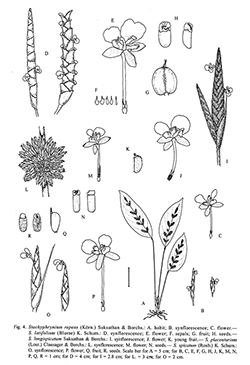e-Flora of Thailand
Volume 9 > Part 2 > Year 2008 > Page 141 > Marantaceae > Stachyphrynium
5. Stachyphrynium repens (Körn.) Suksathan & Borchs.wfo-0000803966
Taxon 54(4): 1086. 2005.— Phrynium repens Körn. in Bull. Soc. Imp. Naturalistes Moscou 35(1): 103. 1862. Fig. 4: A–C.
Accepted Name : This is currently accepted.
Synonyms & Citations :
Description : Rhizomatous ground herb, 38.0–52.5 cm high. Leaves 1–3 per shoot; sheath 6.0–9.8 cm long, green, glabrous to pubescent; petiole 7.7–21.2 cm long, green, glabrous to pubescent; pulvinus 7–12 mm long, densely hairy on upper surface, glabrous to pubescent below, light green; lamina elliptic to oblong, acute to acuminate, 10.3–17 by 3.4–5.4 cm, green to dark green above, with ± short oblique bars of darker green, pale below, glabrous to pubescent. Inflorescence interfoliar, erect, usually simple; peduncle 5–14 cm long; main inflorescence axis 2.7–7.5 cm long; fertile bracts 3–6, distichous, narrowly ovate to narrowly lanceolate, acute, apiculate, 12–20 by 4–9 mm, light green to yellowish-green, glabrous; flower-pairs 2 per special paraclade (usually only 1 pair developed), associated prophylls 9.5–16.0 by 4.0–6.5 mm, interphylls very small, ca 1 mm in diam. Flowers white, 10.5–11.0 cm long; sepals 3, free, small, subequal, 1.2–2.5 by 0.3 mm, white; corolla tube 13.7–18.0 mm long; petal lobes elliptic to oblong, acute, 5.8–6.2 by 1.8–2.7 mm, whitish, translucent, deflexed and curled; staminodal tube ca 0.5 mm longer than corolla tube; outer staminodes 2, subequal, petaloid lobes elliptic to obovate, 7.3–8.0 by 2.8–3.7 mm, white; cucullate staminode with free part of 2.7–3.0 by 1.0– 1.4 mm, tip yellow, appendage very small; callose staminode with free part of 2.6–3.7 by 1.2–2.3 mm, white; fertile stamen 1.0–1.3 mm long, with a small hood-like appendage; style with free part of 3.7–4.8 mm, curved, hooked; ovary 2.5–2.7 mm, glabrous or hairy in upper part. Fruits broadly ellipsoid to obovate, 3.8 by 3.8–5.2 mm. Seeds 1–2, oblong, ca 12.5 by 5.6 mm, rugose; aril large, with 2 appendages, 4–5 mm long.
Thailand : SOUTH-EASTERN: Chachoengsao, Chon Buri, Rayong, Trat (Ko Chang – type of Stachyphrynium minus K.Schum.: Schmidt 741, holotype -C, isotype -K); PENINSULAR: Ranong, Phangnga, Surat Thani, Nakhon Si Thammarat, Phatthalung, Trang, Songkhla, Satun.
Distribution : Indochina, Peninsular Malaysia, Indonesia (Sumatra and Java – type).
Ecology : Common as ground cover under light to shaded conditions in pararubber plantations and lowland evergreen forests, from sea level to 450 m alt.
Vernacular : Suea rong non (เสือรองนอน), sab suea (สาบเสือ)(Southeastern); kalet kawao (กาเล็ดกาเว้า), ret nu (เร็ดหนู)(Peninsular).
Uses: A tiny species with striped leaves, well-known in Thailand as shade loving ornamental plant.
Notes: Stachyphrynium repens is easily recognised by its tiny size and the dark green oblique bands on the upper side of leaves.

